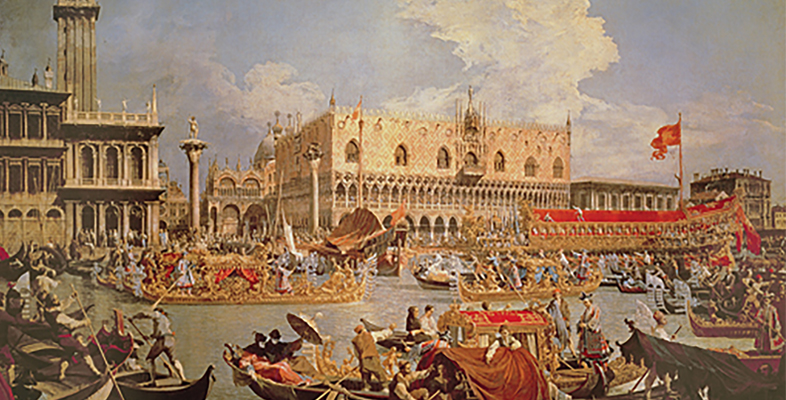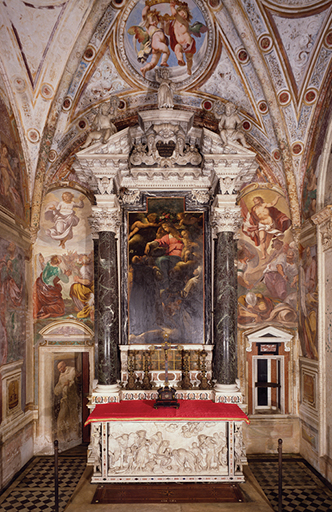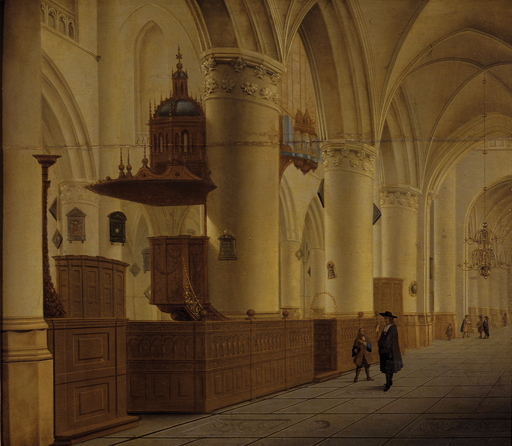6.2 Religion: Reformation and Counter-Reformation
Religion was one of the most important features of life in early modern Europe. The Christian faith was predominant, although there were also Jews and Muslims living in Europe. In 1500 the Catholic Church held enormous power and influence. Across most of the continent, the Pope and a hierarchy of archbishops, cardinals and bishops organised and supervised the work of local priests, who looked after the souls of the people living in a particular area or parish. Religious rituals marked the key events of life: the baptism of newborn children, marriage, and the last rites before death. People prayed to saints for help in times of trouble. The year was divided by religious festivals such as Christmas and Easter, and even dates in the farming calendar – when to plough, or sow, or harvest – often corresponded with days associated with particular saints.
However, the church was increasingly coming under attack from reformers, led by Martin Luther (1483–1546) and John Calvin (1509–1564). They argued against Catholic theology – the understanding of God and his relationship to the world. They also criticised church practices such as selling indulgences (promises that the purchaser would be let off some of the penalties of purgatory), arguing that there was no justification in the Bible for such actions. These debates struck at the most fundamental understanding of God, of the role of the church and of how people should live their lives.
The division between Protestant and Catholic theology
The main points of difference between Luther and the Catholic Church were:
- The source of truth about religion – Catholics had long accepted that the Pope and councils of the church were sources of religious truth. For Luther and other reformers, only the Bible, the word of God, was an authoritative statement of religious truth (the doctrine of sola scriptura).
- The role of the Church – For Catholics, the Church was an essential mediator between God and man: celibate priests were special intermediaries between God and ordinary people. For Luther, everyone was able to communicate with God. Clergy could help their congregations to live a godly life, but lived as ordinary people and were encouraged to marry and have children.
- The sacraments – Sacraments are actions or ceremonies which mark particular points in individuals’ lives. The Catholic Church recognised seven: baptism, confirmation, confession, communion, marriage, the priesthood and extreme unction (the last rites). Luther narrowed these down to just two: baptism and communion. Communion, when Christians communed (became one) with Christ, was also redefined. Catholics believed that priests literally turned the bread and wine used in the ritual into the body and blood of Christ, but reformers held a variety of opinions on whether the act involved an actual transformation or if it was symbolic.
- Salvation – The question of how individuals could ensure that they spent the afterlife in heaven rather than hell was one of profound importance to early modern people. The Catholic Church taught that punishment in purgatory or hell awaited those who misbehaved or sinned while on earth, but that people could gain access to heaven through performing good works and following the Ten Commandments while alive. Luther rejected this, arguing that humans are innately sinful. Only God could grant humans access to the afterlife, which he did to those who believed: people were redeemed by faith alone (the doctrine referred to as sola fide).
Something of the contrast between Catholic and Protestant worship can be seen in Figures 4 and 5. The rich, beautiful image of the Virgin Mary and saints around the altarpiece was designed to encourage prayer (Figure 4), whereas the plain interior of the Calvinist Church offered little to distract the attention of worshippers from the sermon (Figure 5).
The Reformation
By the middle of the sixteenth century, the split between the Catholic Church and reformers had grown too wide for reconciliation. The reformers – who were united in attacking the Catholic Church, but disagreed on significant points of theology – inspired the establishment of many reformed or Protestant churches (the term was derived from a letter of protest written in 1529 in support of Luther’s teachings), including the Lutheran, Calvinist and Methodist churches. While the population of southern Europe remained predominantly Catholic, Protestant churches flourished in the north. The religious division, or Reformation, sparked conflicts, with hundreds of thousands dying for their faith in religious wars.
Luther and his fellow reformers had not set out to create a new church, but had sought to reform the Catholic Church. The popularity of Protestant ideas forced the Catholic Church to embark on a series of reforms, often called the Counter-Reformation, which addressed many of the criticisms launched by Luther. At the Council of Trent, a series of meetings held between 1545 and 1563, members of the Catholic hierarchy reaffirmed the fundamental points of their faith, ordered that priests should be better trained and thus better able to care for their congregations, standardised the mass (the form of church service – the text remained in use until the 1960s) and brought an end to corrupt practices such as selling indulgences.
Activity 7 Two wills from Kibworth, Leicestershire
Wills, like inventories, are basically lists, but they are valuable sources for understanding how people valued certain goods (which might or might not have had a significant monetary value), and how they chose to distribute them to their family and the wider community. They also give us an insight into religious faith and how it changed over time.
Part A: The Will of Katherine Polle
Read the ‘Will of Katherine Polle’, below. Katherine was a Catholic and her will reflects her faith. Then answer the following question:
- Who are the main beneficiaries?
(Note: ‘Sir William Polle’ was not a nobleman: ‘sir’ was a title commonly used to refer to a priest or curate. A ‘trental’ was money left to a priest to pray for the souls of the dead for 30 days.)
[[p. 280]] In the name of God Amen the eighth day of the month of April 1516 I Katherine Poll of Kibworth Harcourt sound of mind and memory make my Testament in this manner. Firstly I leave my soul to almighty God and the Blessed Mary, and my body to be buried in the churchyard of St Wilfrid’s in the parish of Kibworth. Item I leave to the Mother Church of Lincoln 4d. Item I leave for the repair of the parish church of Kibworth aforesaid 20s. Item I leave for the repair of the Chapel of St Leonard of Smeeton 3s 4d. Item I leave to Margaret my daughter 53s 4d. Item I leave to Sir William Polle my son to celebrate one trental for prayers for the health of my soul and all the faithful departed 10s. [[p. 281]] Item I leave to each of the priests who celebrate my exequies [funeral rites] 6d. Whatever truly remains of my goods I leave my executors Sir William Polle and Thomas Clerke of Kibworth Beauchamp to despose of as they think fit for the good of my soul and to be supervisor of my testament Sir Walter Lucas Rector of the church of Kibworth.
Discussion
Katherine leaves money to churches – her local churches at Kibworth and Smeeton and a larger church at Lincoln. She also leaves money to priests to conduct her funeral and say prayers. By far the largest sum is bequeathed to her family: her daughter is to receive a much larger sum than the other people and places mentioned. She also leaves something to be distributed by her executors, possibly to the poor of the parish.
The will shows Katherine’s concern with the welfare of her soul. She formally leaves her soul to God, and she ensures that prayers will be said and that other good deeds will be performed on her behalf by her executors, which will help her soul to pass through purgatory to heaven.
Part B: The Will of Thomas Ray, farmer, 1559
Thomas Ray died in the reign of Elizabeth I, when the Protestant faith was the official religion.
Read the ‘Will of Thomas Ray’. Compare this with the will of Katherine Polle, which you read in Part A, and answer the following questions:
- Does Ray’s will suggest a different attitude to the welfare of his soul?
- What would you say was Ray’s main concern when drawing up his will?
In Nomine Dei the year of our lord God 1559 the 18th of October, I Thomas Rey of Kibworth Harcourt In the County of Leicester, gentleman, sick in body but thanks be to God in perfect mind & memory, make & ordain that my last will & testament in manner following. First I bequeath my soul to almighty God & and my body to be buried within the church of the said Kibworth. Item I bequeath to the mother church of Lincoln 4d. Item to the poor of the parish ten shillings. Item I bequeath to Michael Coxon two kine [pigs] and eleven hoggerylles [piglets] one featherbed & all things belonging unto it with part of my apparel at the discretion of my wife, my debts and funeral expenses discharged. The residue of my goods unbequeathed I give to Margaret my wife and Nicholas my son whom I make my full executors of all my goods moveable & unmoveable to be distributed betwixt them too by equal portions; also I will that Nicholas my said heir the lease of my farm when he cometh to lawful age with all his goods & if it fortune my wife to marry away from the farm then I will that Michael Coxon have the occupation of that said farm till my son cometh to lawful age & if it fortune that God call my son to his mercy before he come to lawful age Then I Will that his goods be divided equally betwixt my wife & Michael Coxon aforesaid. Also I do make Nicholas Cloudsley superviser that this my last will and testament be performed. And for his pains I give him an old ahsell [a donkey?] for a token
Discussion
The two wills begin in a similar way: Ray gives his soul to God, and leaves money to a church. He also gives a set sum to the poor living in the parish. However, there is nothing about the welfare of his soul – no money to priests or for prayers. This reflects the different understandings in Catholic and Protestant faiths of how souls could reach heaven.
Most of Ray’s will is concerned with distributing his worldly goods to family and friends. He is very concerned that his farm should pass to his son and he makes special arrangements to ensure that it will stay in the family if his wife marries again.


